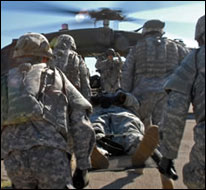Between 2001 and 2010, more than 1,300 American service members suffered full or partial amputation of an arm or leg due to injuries sustained while fighting in Iraq or Afghanistan, according to a Congressional Research Service report. Prosthetic technologies continue to improve, but how much is this affecting the quality of life for these amputees? A 2012 study, “Combat-incurred Bilateral Transfemoral Limb Loss: A Comparison of the Vietnam War to the Wars in Afghanistan and Iraq,” compares veterans across generations to examine improvements in amputee care and rehabilitation.
The study, published in the Journal of Trauma and Acute Care Surgery, compares factors such as “self-reported health status, quality of life, function, and prosthetic use” of veterans with bilateral transfemoral (above the knee) limb loss as a result of combat injuries either in Iraq/Afghanistan or Vietnam. As one of the most severe types of injuries, bilateral transfemoral amputation often results in higher mortality rates and longer stays in the hospital, presenting challenges for both long and short-term care. To conduct the study, the researchers — from the University of Michigan, the University of Washington and the Veterans Administration system — identified amputees from the Department of Veterans Affairs databases and conducted surveys during 2007 and 2008 by mail, telephone or online. In total, there were 298 participants from the Vietnam conflict and 283 from the Iraq/Afghanistan conflicts. Both groups were similar in the distribution of gender and type of amputation, though there were more Vietnam participants who had sustained multiple limb losses.
The study’s key findings include:
- Among the participants, bilateral transfemoral limb loss was more common for the Vietnam veterans (23 of 298 surveyed, or 7.7%) compared with the Iraq/Afghanistan veterans (10 of 283 surveyed, or 3.5%).
- Only 17% of the Vietnam veterans were using advanced ‘‘electronic’’ prostheses, while 60% of the Iraq/Afghanistan group reported using at least one; 65.3% of those from the Vietnam group reported that they couldn’t walk with prostheses, while this proportion was only 30% for those from the Iraq/Afghanistan group.
- However, regardless of the type of prostheses used, the average level of prosthetic satisfaction was statistically similar for the Vietnam and Iraq/Afghanistan groups; 100% from the Vietnam group and 85.7% from the Iraq/Afghanistan group responded: “I am satisfied with my prosthesis.”
- The employment rate of the Vietnam veterans was 77.3%, while for Iraq/Afghanistan veterans it was 60%.
- About 68% of the Vietnam veterans reported being married or living with a partner, compared with 60% of the Iraq/Afghanistan group.
- Forty-one percent of the Vietnam group rated their health as ‘‘very good to excellent,” compared with 80% of the Iraq/Afghanistan group.
The researchers conclude that the “service members with bilateral transfemoral limb loss were remarkably similar for the two conflict groups in regard to nature of injuries and reported quality of life, but showed significant differences in prosthetic use and levels of function.”
Tags: veterans, war


Expert Commentary